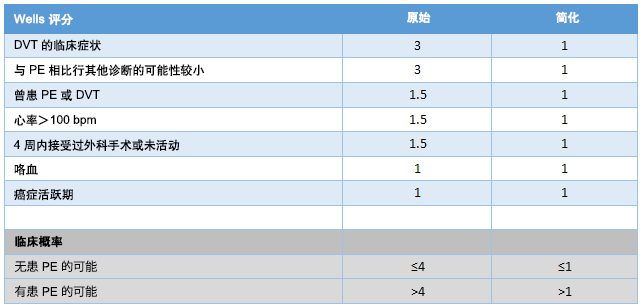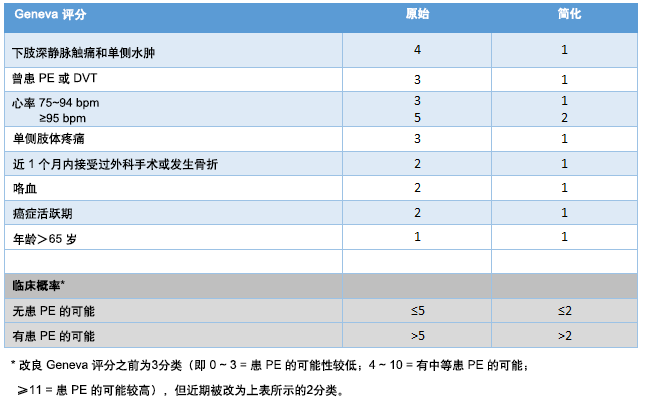临床决策原则
通过使用原始 Wells 评分(修订)、简化 Wells 评分(修订)、原始 Geneva 评分(改良)或简化 Geneva 评分(改良),可将疑似 PE 患者依据临床(验前)概率分成不同的类别,该分类符合确诊 PE 的实际患病率。[75]Konstantinides SV, Torbicki A, Agnelli G, et al; Task Force for the Diagnosis and Management of Acute Pulmonary Embolism of the European Society of Cardiology (ESC). 2014 ESC guidelines on the diagnosis and management of acute pulmonary embolism. Eur Heart J. 2014 Nov 14;35(43):3033-69.https://academic.oup.com/eurheartj/article/35/43/3033/503581http://www.ncbi.nlm.nih.gov/pubmed/25173341?tool=bestpractice.com[88]Wells PS, Anderson DR, Rodger M, et al. Derivation of a simple clinical model to categorize patients' probability of pulmonary embolism: increasing the model's utility with the SimpliRED D-dimer. Thromb Haemost. 2000 Mar;83(3):416-20.http://www.ncbi.nlm.nih.gov/pubmed/10744147?tool=bestpractice.com[89]Le Gal G, Righini M, Roy PM, et al. Prediction of pulmonary embolism in the emergency department: the revised Geneva score. Ann Intern Med. 2006 Feb 7;144(3):165-71.http://www.ncbi.nlm.nih.gov/pubmed/16461960?tool=bestpractice.com 这些临床决策工具为一系列的病史和体格检查特征赋值(一分或多分),分值总和决定是否有患 PE 的可能性。
 [Figure caption and citation for the preceding image starts]: 原始和简化 Wells 评分标准(修订)由 BMJ Knowledge Centre 编制 [Citation ends].
[Figure caption and citation for the preceding image starts]: 原始和简化 Wells 评分标准(修订)由 BMJ Knowledge Centre 编制 [Citation ends].
 [Figure caption and citation for the preceding image starts]: 原始和简化 Geneva 评分标准(改良)由 BMJ Knowledge Centre 编制 [Citation ends].
[Figure caption and citation for the preceding image starts]: 原始和简化 Geneva 评分标准(改良)由 BMJ Knowledge Centre 编制 [Citation ends].
由于使用简便,简化版的修订 Wells 评分标准和改良 Geneva 评分标准在临床上可能是首选。[90]van Es N, Kraaijpoel N, Klok FA, et al. The original and simplified Wells rules and age-adjusted D-dimer testing to rule out pulmonary embolism: an individual patient data meta-analysis. J Thromb Haemost. 2017 Apr;15(4):678-84.https://onlinelibrary.wiley.com/doi/full/10.1111/jth.13630http://www.ncbi.nlm.nih.gov/pubmed/28106338?tool=bestpractice.com两种简化版的评分标准都已经验证;未证明两者中的其中一种优于另一种。[74]Raja AS, Greenberg JO, Qaseem A, et al. Evaluation of patients with suspected acute pulmonary embolism: best practice advice from the Clinical Guidelines Committee of the American College of Physicians. Ann Intern Med. 2015 Nov 3;163(9):701-11.http://annals.org/aim/fullarticle/2443959/evaluation-patients-suspected-acute-pulmonary-embolism-best-practice-advice-fromhttp://www.ncbi.nlm.nih.gov/pubmed/26414967?tool=bestpractice.com[91]Hendriksen JM, Geersing GJ, Lucassen WA, et al. Diagnostic prediction models for suspected pulmonary embolism: systematic review and independent external validation in primary care. BMJ. 2015 Sep 8;351:h4438.https://www.bmj.com/content/351/bmj.h4438.longhttp://www.ncbi.nlm.nih.gov/pubmed/26349907?tool=bestpractice.com但是,Geneva 评分完全基于客观的临床指标,故可能重复性更强(Wells 评分标准 [原始和简化版] 包括主观的‘其他鉴别诊断的可能性低于 PE’这一临床指标)。[92]Klok FA, Kruisman E, Spaan J, et al. Comparison of the revised Geneva score with the Wells rule for assessing clinical probability of pulmonary embolism. J Thromb Haemost. 2008 Jan;6(1):40-4.https://onlinelibrary.wiley.com/doi/full/10.1111/j.1538-7836.2007.02820.xhttp://www.ncbi.nlm.nih.gov/pubmed/17973649?tool=bestpractice.com
肺栓塞排除标准 (PERC)
美国内科医师学会的指南推荐,对于 PE 的临床可能性非常低的患者,应使用 PERC。[74]Raja AS, Greenberg JO, Qaseem A, et al. Evaluation of patients with suspected acute pulmonary embolism: best practice advice from the Clinical Guidelines Committee of the American College of Physicians. Ann Intern Med. 2015 Nov 3;163(9):701-11.http://annals.org/aim/fullarticle/2443959/evaluation-patients-suspected-acute-pulmonary-embolism-best-practice-advice-fromhttp://www.ncbi.nlm.nih.gov/pubmed/26414967?tool=bestpractice.com
对于符合所有标准(年龄 <50 岁;初始心率<100 bpm;呼吸室内空气的初始氧饱和度 >94%;无单侧腿肿;无咯血;在过去 4 周内无手术或外伤;无静脉血栓栓塞史;未使用雌激素)的患者,发生 PE 的风险低于检测的风险,因此无需进一步检查。可使用 D-二聚体检测对不符合所有 PERC 标准的患者进行分类。[74]Raja AS, Greenberg JO, Qaseem A, et al. Evaluation of patients with suspected acute pulmonary embolism: best practice advice from the Clinical Guidelines Committee of the American College of Physicians. Ann Intern Med. 2015 Nov 3;163(9):701-11.http://annals.org/aim/fullarticle/2443959/evaluation-patients-suspected-acute-pulmonary-embolism-best-practice-advice-fromhttp://www.ncbi.nlm.nih.gov/pubmed/26414967?tool=bestpractice.com
一项关于评估使用 PERC 排除 PE 的 Meta 分析报道的敏感度为 97%。[94]Singh B, Mommer SK, Erwin PJ, et al. Pulmonary embolism rule-out criteria (PERC) in pulmonary embolism - revisited: a systematic review and meta-analysis. Emerg Med J. 2013 Sep;30(9):701-6.http://emj.bmj.com/content/30/9/701.longhttp://www.ncbi.nlm.nih.gov/pubmed/23038695?tool=bestpractice.com
 [Figure caption and citation for the preceding image starts]: 原始和简化 Wells 评分标准(修订)由 BMJ Knowledge Centre 编制 [Citation ends].
[Figure caption and citation for the preceding image starts]: 原始和简化 Wells 评分标准(修订)由 BMJ Knowledge Centre 编制 [Citation ends]. [Figure caption and citation for the preceding image starts]: 原始和简化 Geneva 评分标准(改良)由 BMJ Knowledge Centre 编制 [Citation ends].
[Figure caption and citation for the preceding image starts]: 原始和简化 Geneva 评分标准(改良)由 BMJ Knowledge Centre 编制 [Citation ends].